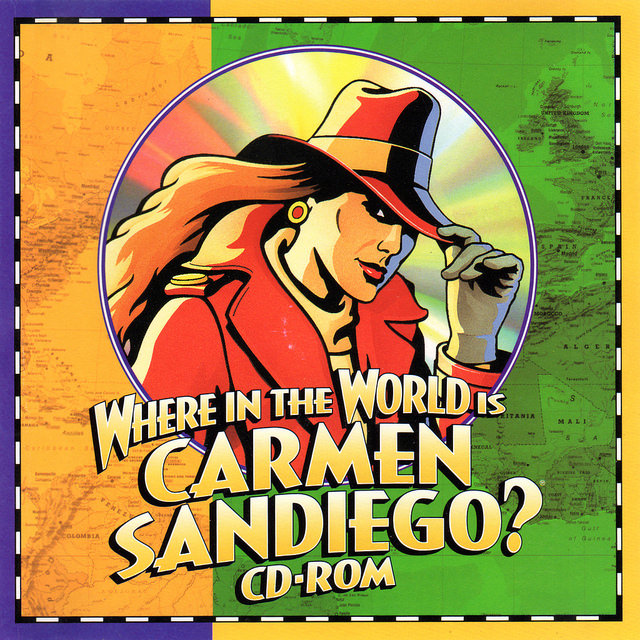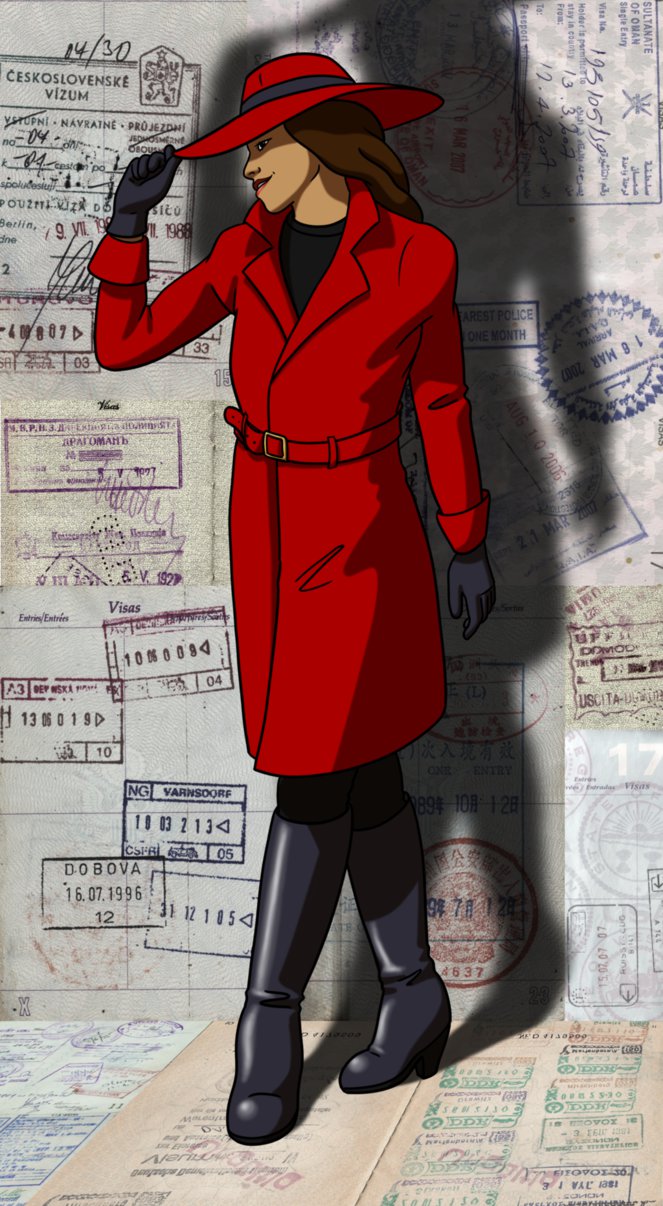By Joy Lisi Rankin
“Well, she’ll ransack Pakistan and run a scam in Scandinavia …Tell me, where in the world is Carmen Sandiego?” So run the lyrics to the a cappella theme song performed by Rockapella for the PBS show Where in the World is Carmen Sandiego? During the 1980s and 1990s, Carmen Sandiego centered an unlikely media juggernaut, one that began as a computer game and spun off multiple other games, including French and Spanish versions, two television shows, one produced by PBS and another by Fox called Where on Earth is Carmen Sandiego?, the theme song, books, and board games. Netflix is now capitalizing on popular nostalgia for Carmen, producing both a rebooted animated series and a live-action feature film.
But how did Carmen, which originated as a mystery game wherein players solved geography and history clues, become this lucrative and beloved global franchise? The story traditionally told points back to Brøderbund software and Carmen’s game designers, a group of men including Lauren Elliott, Gene Portwood, and Dane Bigham. This traditional story, like so many others in the history of science and technology, narrowly defines technology and technological success, thus expunging the work of women.

Where in the World is Carmen Sandiego CD-ROM, Brøderbund, 1995 | Flickr
During the 1980s, Brøderbund software rose to prominence in the personal computer software market with programs including Bank Street Writer, The Print Shop, and the various Carmen iterations: Where in — the World / Europe / the United States / Space / Time — is Carmen Sandiego? In PC folklore, Brøderbund is remembered for a few intertwined features. The name is a made-up, mash-up word of the Danish, Norwegian, and Swedish words for “brothers” - brødre or bröder, and the German word for “alliance” - bund. As the story goes, Brøderbund was founded in 1980 by two brothers, Doug and Gary Carlston. In fact, the journalist Steve Levy’s popular 1984 book Hackers: Heroes of the Computer Revolution refers in its index to “Brotherhood (Brøderbund) software,” and in those pages, Levy recounts Doug and Gary’s partnership. Doug abandoned his law practice, then recruited his brother Gary away from “a job so desirable that grown men gasped when he mentioned it - coach of a Scandinavian women’s basketball team.” The implication here was that the brothers' starry-eyed software passion was strong enough to lure them away from the security of law and the sex appeal of statuesque Scandinavian women. Two men, two brothers, behind Brøderbund, and throw in Carmen’s programmers make for a masculine conglomerate.
But another 1984 publication depicted the “Carlston triumvirate,” with sister Cathy Carlston as essential to the company’s success. The September 1984 issue of Creative Computing profiled rising software star Brøderbund as “A Family Affair.” Cathy, who joined the venture in 1981, had played a fundamental role in establishing it. The Creative Computing article nonetheless downplayed Cathy’s contribution by introducing her under the subheading, “The Woman’s Touch,” which conjured images of domestication and homemaking: a woman sewing curtains, soothing a baby, or serving a meatloaf. Creative Computing described Cathy’s background in fashion marketing, and how she did Brøderbund’s bookkeeping at the kitchen table, emphasizing femininity and providing a contrast to its coverage of Doug and Gary’s Harvard degrees and software zeitgeist chutzpah. Creative Computing added anecdotally that Cathy was pleased to attend the 1981 West Coast Computer Faire and see that Brøderbund was “recognized and indeed respected,” which suggests that she perhaps previously had been skeptical about this software business.
More significantly, Brøderbund itself, as a company, publicly recognized and promoted Cathy as a founder. The summer 1988 Brøderbund newsletter featured an article in which Cathy, Doug, and Gary are described as “Brøderbund’s founders,” with a photograph of all three of them. In a 2004 oral history interview, Doug described how all three of the Carlston siblings — he, Gary, and Cathy — performed a variety of functions in establishing and growing the business. Doug explained, “Oh, we often did work 24-hour days … regularly, Gary and Cathy and I worked the assembly line and not just for an hour to show off. We worked full shifts and often we worked the graveyard shift (12 midnight to 8 am) or we did something that was particularly unattractive, because it was important that we make a deadline.” Describing Cathy’s work in particular, Doug commented, “People did what they were good at and it didn’t always stay that way. Cathy eventually became our primary contact for educational sales and marketing. She also took over the bookkeeping from me for a time. We kind of just worked our way through it. There was no clear chain of command.” Clearly, Brøderbund deemed Cathy essential to its establishment and success, but contemporaneous and subsequent coverage effaced her work.
Cathy Carlston propelled Carmen’s popularity through her focus on educational outreach for Brøderbund. At a time when educators (and parents) searched for uses for personal computers, Cathy convinced school teachers that the game would help their students learn geography and history. She launched an educational outreach group “to create products that offer a variety of applications for students, teachers and home users alike. That's a unique objective and I think it's one of the reasons behind our success.”
Cathy and her team bridged the gap between computing time and classroom time by popularizing Carmen Sandiego days. In fact, the Carmen programmer Elliott emphasized Cathy’s role in stoking Carmen’s popularity, stating, “its success in the schools was the first real marketing boost (and it was free).” Although Elliott and Portwood may have developed the initial Carmen game, Cathy implanted it in schools, emphasized its utility to teachers, and made it fun, educational, and ultimately beloved by students.
Cathy Carlston’s story is a microcosm for how technology narratives have been and continue to be written. The realms of office management, of marketing, of education aren’t considered technology, especially high-tech, because women typically do that work.
As I argue in my book A People’s History of Computing in the United States, education has been an important yet overlooked site of personal and social computing. This was certainly true for computing during the 1980s. In his 1995 oral history interview with the Smithsonian, Steve Jobs explained, “One of the things that built Apple II's was schools buying Apple II's.” In other words, schools — and teachers — were foundational to Apple’s early success. Similarly, schools — and teachers — were foundational to Carmen’s success. And Cathy Carlston cultivated that educational empire.
Cathy Carlston’s story is a microcosm for how technology narratives have been and continue to be written. The realms of office management, of marketing, of education aren’t considered technology, especially high-tech, because women typically do that work. In other words, as Miriam Posner, Mar Hicks, and Rebecca Ortenberg, among many others, have pointed out, technology repeatedly has been defined and redefined to exclude what women do. The erasure of women’s work doesn’t just happen in technology; it happens because of how we define technology to begin with. When we fail to recognize the work that happens in homes or schools as technological, we fail at history. When we fail to recognize the bookkeeping, the marketing, and the managing as foundational to the success of a “technological” company, we fail at history.
I played Carmen Sandiego on my family’s Commodore 128 home computer. I am a member of that Oregon Trail generation. I am a historian, and I’ve studied the histories of Brøderbund and Carmen. And the first time — the first time — I encountered the name Cathy Carlston was when I began researching this essay, and I found her mentioned in the inaugural Brøderbund newsletter. Cathy Carlston Brisbois died in 1995 at the age of 39. She’s no longer walking the earth, but I want to make sure she, and the many other women in the sisterhood of la technologie, continue to walk the pages of history.
Further Reading
Shira Chess, Ready Player Two: Women Gamers and Designed Identity (Minneapolis: University of Minnesota Press, 2017)
Anastasia Salter and Bridget Blodgett, Toxic Geek Masculinity in Media: Sexism, Trolling, and Identity Policing (Cham, Switzerland: Springer Nature / Palgrave Macmillan, 2017)
Lady Science is an independent magazine that focuses on the history of women and gender in science, technology, and medicine and provides an accessible and inclusive platform for writing about women on the web. For more articles, information on pitching, and to subscribe to our newsletter, visit ladyscience.com.
